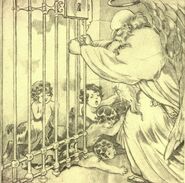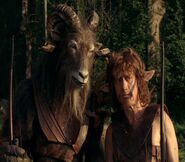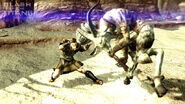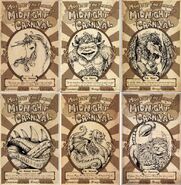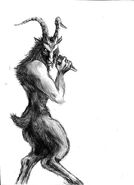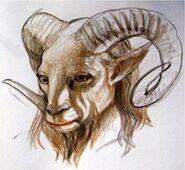In Greek mythology; satyrs are a troop of male companions of Pan and Dionysus that roamed the woods and mountains. The word Satire, meaning human follies or mistakes, comes from the word Satyr.
Characteristics[]
As Dionysiac creatures, they are lovers of wine, women, and boys, and are ready for every physical pleasure. They roam to the music of pipes (auloi), cymbals, castanets, and bagpipes, and love to dance with the Nymphs (with whom they are obsessed, and whom they often pursue), and have a special form of dance called sikinnis. Because of their love of wine, they are often represented holding winecups and appear often in the decorations on winecups.
Satyrs are described as roguish but faint-hearted folk — subversive and dangerous, yet shy and cowardly. They are also often depicted as fumbling, joking, and careless creatures.
Appearance:[]
Satyrs are male goat-human hybrids with the torso and head of a man, and in Greek tradition with the legs, and tail of a horse. Originally, Satyrs also had human feet before Roman alterations. They are often depicted with flat noses, large pointed ears, long curly hair, and full beards, with wreaths of vine or ivy circling their balding heads.
- "Satyresses" were a late invention of poets, and female Satyrs are rare to uncommon even in more modern depictions.
Satyrs acquired their goat-like aspect through later Roman conflation with Faunus, a carefree Italic nature spirit of similar temperament. Hence satyrs are most commonly described in Latin literature as having the upper half of a man and the lower half of a goat. In Roman art, ature Satyrs have long goat's horns, while juveniles are often shown with bony nubs on their foreheads.
In Greek Culture[]
Greek Theater "Satyr Plays":[]
The satyr play was a lighthearted follow-up attached to the end of each trilogy of tragedies in Athenian festivals honoring Dionysus. These plays would take a lighthearted approach to the heavier subject matter of the tragedies in the series, featuring heroes speaking in tragic iambic verse and taking their situation seriously as to the flippant, irreverent and obscene remarks and antics of the satyrs.
The only remaining satyr plays are "Cyclops" by Euripides, and the fragments of "The Tracking Satyrs (Ichneutae)" by Sophocles. The groundbreaking tragedy playwright Aeschylus is said to have been especially loved for his satyr plays, but none of his have survived.
Greek Art:[]
On painted vases and other Greek art, satyrs are represented in the three stages of a man's life: mature satyrs are bearded and are shown as fat and balding, both a humiliating and unbecoming disfigurement in Greek culture. Satyrs often carry the thyrsus: the rod of Dionysus tipped with a pine cone.
Satyrs in Christianity[]
As Christianity spread throughout the Mediterranean, satyrs were increasingly associated with the basal instincts and passions. With that association also came an association with the demonic. Over time demons and the Devil himself were increasingly depicted as satyr-like creatures.
In Medieval Bestiaries:[]
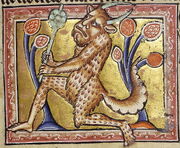
Satyr image from the Aberdeen Bestiary, 12th Century, England.
Medieval bestiaries were not naturalistic or scientific descriptions of animals, like what you would expect from a modern encyclopedia. Instead their purpose was theological. Bestiaries were collections of moral and symbolic stories about animals, plants, and sometimes stones which served to show how all of the natural world is part of God's creation.
Within medieval bestiaries there are said to be five categories of apes, with one of the five said to be called "satyrs." Two more of the categories are also named after mythological creatures: the sphinxes and the Cenophali (cynocephali, or dog-headed men). Even though the entry seems to describe a type of ape that just happens to be called a satyr, nevertheless the accompanying artwork shows a mythological satyr holding a staff, thus blurring the lines between the animal and the mythological creature.
The Aberdeen Bestiary is a bestiary from 12th century England. The excerpts from the ape entry are as follows:
- Apes are called simie in Latin because the similarity between their mentality and that of humans is felt to be great. Apes are keenly aware of the elements; they rejoice when the moon is new and are sad when it wanes.
- A characteristic of the ape is that when a mother bears twins, she loves one and despises the other. If it ever happens that she is pursued by hunters, she carries the one she loves before her in her arms and the one she detests on her shoulders. But when she is tired of going upright, she deliberately drops the one she loves and reluctantly carries the one she hates.
- The ape does not have a tail. The Devil has the form of an ape, with a head but no tail. Although every part of the ape is foul, its rear parts are disgusting and horrid enough. The Devil began as an angel in heaven. But inside he was a hypocrite and a deceiver, and he lost his tail, because he will perish totally at the end, just as the apostle says: 'The Lord shall consume him with the spirit of his mouth.' (2 Thessalonians, 2:8)
- The name symia is Greek, meaning, 'flattened nostrils'. Hence we call the ape symia because they have compressed nostrils and a hideous face, its creases foully expanding and contracting like a bellows; although she-goats also have a flattened nose.
- The apes called circopetici have tails. This alone distinguishes them from the apes mentioned earlier.
- Cenophali (cynocephali) are numbered among the apes. They occur in great numbers in parts of Ethiopia. They leap wildly and bite fiercely. They are never so tame, that their ferocity does not increase.
- Sphynxes are also included among apes. They have shaggy hair on their arms and are easily taught to forget their wild nature.
- Of satyrs: There are also apes that men call satyrs. They have quite attractive faces, and are restless, making pantomimed gestures.
- The apes called callitrices differ from the others in almost every aspect of their appearance. They have bearded faces and broad tails. It is not difficult to catch them but they rarely survive in captivity. They do not live elsewhere than under the Ethiopian sky, that is their native sky.
In Popular Culture[]
Film:[]
- Philoctetes ("Phil") is a Satyr in Disney's Hercules.
Literature:[]
- Satyrs as well as Fauns appear in the Chronicles of Narnia
- Grover Underwood is a satyr in the Percy Jackson and the Olympians series.
- Gleeson Hedge is a satyr in the Trials of Apollo and Heroes of Olympus series along with his son Chuck Hedge.
Video Games:[]
- In Spyro: Ripto's Rage, one of the races in a world are Satyrs
- Satyrs appear in God of War II
Gallery[]
External links[]
- Satyr and Silenus on Britannica

